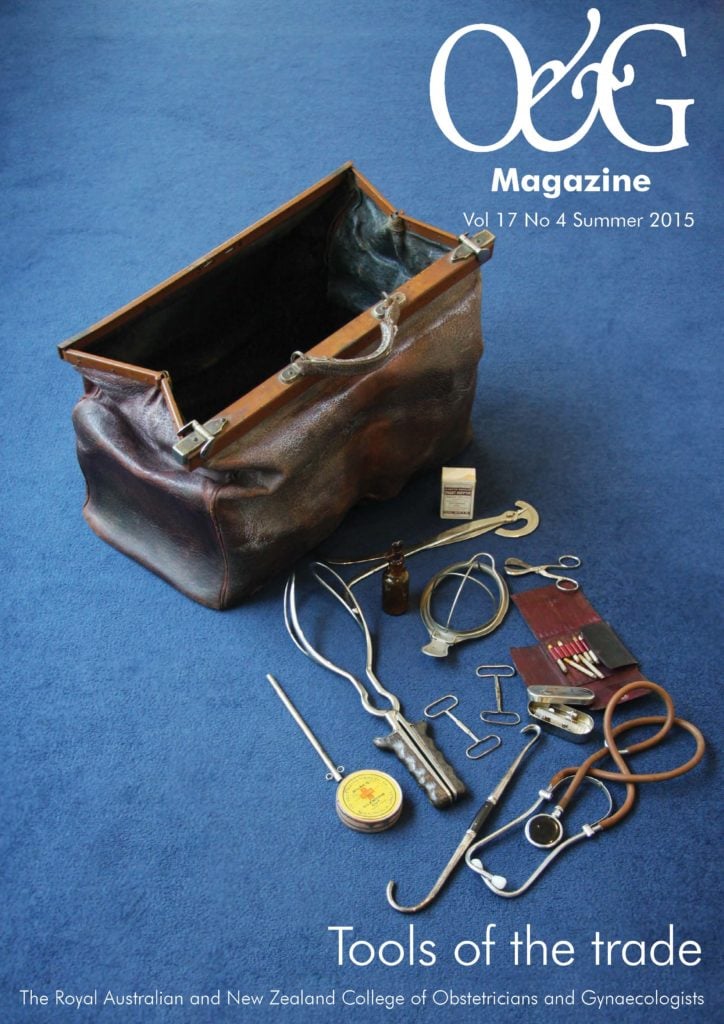Caesarean on maternal request
The following views expressed by the authors are their own; for more information regarding RANZCOG’s position on Caesarean Delivery on Maternal Request, please see the College guideline (C-Obs 39).
I’d like to comment on the article ‘When the professional becomes personal’ in O&G Magazine Vol 17 No 3 Spring 2015. The author, despite having had two elective caesarean sections in private herself, states that she ‘still believes that caesarean section for maternal request should be denied’ (in the public sector).
This article, like little else in the entire literature on the topic, illustrates the degree to which we have been confused and misled by the ideology of natural childbirth. Should it not be possible to discuss the issue of elective caesarean on maternal request rationally? We are, after all, supposed to believe in the scientific paradigm, not ideology.
Elective caesarean has a number of indisputable benefits, which to date have rarely been disclosed to patients and are commonly ignored by obstetricians and midwives. In fact, many obstetricians in public hospitals actively try not to think about those benefits in order to reduce what can only be described as cognitive dissonance. Briefly, these can be listed as:
- Elective caesarean is associated with reduced perinatal mortality compared to a planned vaginal birth; simply owing to the fact that elective caesarean results in earlier delivery. Every day spent in utero carries a risk of unexplained stillbirth. Between 38+ and 40+ weeks gestation this amounts to between 1:500 and
1:2000 excess perinatal deaths1 for planned vaginal birth. - Elective caesarean prevents anal sphincter tears, which are much more common than previously assumed at 10–20 per cent of the vaginally parous population2, and the main aetiological factor for faecal incontinence in women, which requires about 10 000 surgical procedures per annum in the US alone.
- Elective caesarean prevents levator tears and irreversible hiatal over-distension, which affect 12–35 per cent of women after a first vaginal birth3 and which are the main aetiological factors for female pelvic organ prolapse. This likely is the strongest public health argument for elective caesarean, with an estimated 100 000 procedures per annum in the US directly or indirectly owing to levator trauma.
There are multiple other less-obvious benefits, such as the avoidance of psychological trauma up to and including post-traumatic stress disorder4, psychosexual issues and partnership problems owing to traumatic childbirth.
Hence, there can be little doubt that, from the patient’s angle, elective caesarean is a rational decision. Not inevitable, surely, given that fact that this choice has substantial downsides, but entirely rational. The older the patient and the lower the number of desired offspring, the more rational it is. The ethical precept of beneficence/non-maleficence can most certainly not be used to deny a caesarean on maternal request.
There remains the argument that elective caesarean is more expensive, that is, more resource intensive in a resource-limited environment. This is a fallacy. The difference in short- to medium-term cost has been estimated at £84 by the National Institute for Health and Care Excellence (NICE).5 That’s without accounting for prolapse, faecal incontinence or stillbirth. Hence, the ethical precept of justice cannot be used to deny an elective caesarean on maternal request.
Finally, let’s consider the interests of the obstetrician. As many of our readers will be aware, the UK Supreme Court has recently delivered a decision that will have substantial consequences for antenatal and intrapartum consent. In the Montgomery versus Lanarkshire judgment the pertinent text reads as follows: ‘Where either mother or child is at heightened risk from vaginal delivery, doctors should volunteer the pros and cons of that option compared to a caesarean’. Not just agree to a maternal wish – to voluntarily offer it. And do I really have to mention the universal ethical and legal principle of autonomy to affirm the right of every pregnant woman to decide on an elective caesarean herself? We’re pro- choice, aren’t we?
Despite disparities in health service delivery and legal systems, Australian courts tend to take UK precedents seriously, and a UK Supreme Court decision will have consequences in Australia. Hence, with at least half of antenatal women – most primiparae, anybody at age 30 or above, any gestational diabetic, anyone with a macrosomic child, with a BMI of over 30, a long closed cervix at term, a high head, anyone going over term and so on – the obstetrician will in future have to discuss the option of elective caesarean. The obstetrician will have to bring it up and, of course, will have to agree to an elective caesarean if the patient so chooses. Not doing so will end doctors up in court and may cost them their livelihood. Better change tack now before it is too late.
However, it already may be too late. The Montgomery versus Lanarkshire decision referred to a case of shoulder dystocia that occurred in 1999. A decision to deny a patient an elective caesarean that occurred within the last ten years is now probably indefensible in court, and no NSW Health Policy Directive, RCOG or RANZCOG guideline, is going to save us and our services from the resulting consequences.
References
- Vashevnik, S., S. Walker, and M. Permezel, Stillbirths and neonatal deaths in appropriate, small and large birthweight for gestational age fetuses. Aust NZ J Obstet Gynaecol, 2007. 47: p. 302-306.
- Guzman Rojas, R., et al., Prevalence of anal sphincter injury in primiparous women. Ultrasound Obstet Gynecol, 2013. 42(4): p.461-466.
- Dietz, H., Pelvic Floor Trauma in Childbirth. Aust NZ J Obstet Gynaecol, 2013. 53: p. 220-230.
- Skinner, E. and H. Dietz, Psychological consequences of traumatic vaginal birth. Neurourol Urodyn, 2015. 34(in print).
- Anonymous. Caesarean Section: NICE Clinical Guideline 132. 2011 [retrieved 20.10.2015 from: www.nice.org.uk/guidance/CG132/documents/caesarean-section-update-full-guideline2.






Leave a Reply